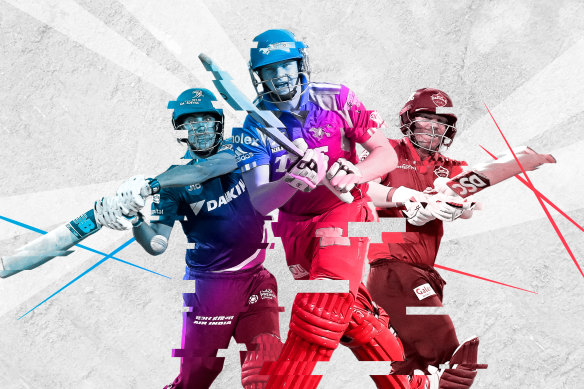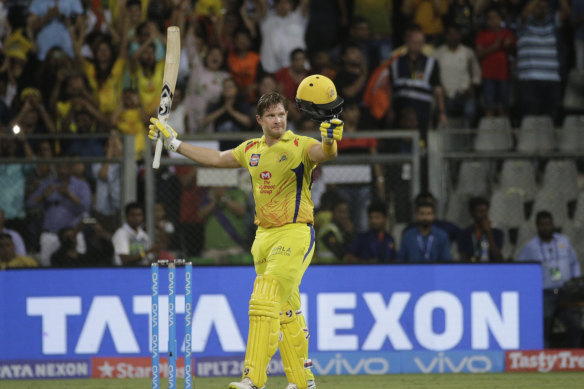- Exclusive
- Sport
- Cricket
- Australian cricket
This was published 2 years ago
The raid on Australia’s best players that could redefine international cricket
Senior Australian cricketers are being targeted by Indian Premier League giants to sign multi-club deals worth up to $US5 million ($7.5 million) in a sweeping disruption of the global cricket economy.
Top players including Test captain Pat Cummins, Steve Smith, Glenn Maxwell, David Warner, Josh Hazlewood, Mitchell Marsh, Marcus Stoinis, Adam Zampa and Mitchell Starc are in the sights of IPL conglomerates, which have bought Twenty20 franchises across the globe and are looking to sign cricketers to deals across multiple tournaments.

Australian stars (from left) Glenn Maxwell, Steve Smith and David Warner.Credit: Illustration: Stephen Kiprillis, The Age
The Age and The Sydney Morning Herald have spoken to players, their agents, administrators and others involved in the business of cricket who confirmed the shift in the cricket landscape, which could be the most profound change to the sport since Kerry Packer’s World Series Cricket upheaval in the late 1970s.
Since the establishment of the IPL in 2008, star cricketers have been increasingly lured by lucrative contracts to focus on the short form of the game, at times in competition with international duties.
Neil Maxwell, one of Australia’s most influential player agents, said the next phase of the IPL revolution would have players asking for permission from their Indian owners to represent Australia, not the other way around.
“It’s imminent and it’s happening,” Maxwell, who manages Cummins and Hazlewood, told The Age and the Sydney Morning Herald in a special series on how the IPL has changed cricket.
“Very soon players will be asking for non-objection certificates from their clubs because some are already signing all-encompassing contracts with them. The IPL is currently paying players something like 6 to 8 per cent of its revenues.
“The best Australian players who consistently rank as the best in the world for a number of years will earn about $US1.5 million from Australian cricket, playing 12 months of the year to achieve that. The maths don’t work.”
After world cups in India and the USA this year and next, 2025 looms as the year when a group of Australian players will start to snap the bonds of the traditional Cricket Australia contract system to take up such deals and represent Indian brands in multiple leagues.
Offers are already on the table for some Australian white-ball players. Typically, these involve three-tournament deals worth at least $US500,000 for the UAE or South Africa leagues, plus the Caribbean Premier League and the fledgling Major League Cricket tournament in the United States. Far bigger bundles – as much as $US5 million – would be on the table for players already tied to IPL franchises.
All the while, interested parties wait to learn whether the Board of Control for Cricket in India (BCCI) will allow for the IPL salary cap to be increased in line with the value of last year’s $US6 billion broadcast deal with Star and Viacom, which would mean $10 million deals for top players are not out of the question.
“The IPL has got conservatively another 45 per cent of its revenues that it can allocate to players, per any international sports organisation,” Neil Maxwell said.
“Even if it got to 20 per cent, it’s a game-changer. My understanding is that they [the BCCI] don’t want to increase player payments as it will cause greater pressure on national boards that can’t compete.”
IPL owners have also considered how much money would be required to hoist young Australian players out of the domestic system and into long-term deals to follow someone such as 19-year-old South African Dewald Brevis, the “mini-AB de Villiers” branded as a Mumbai Indian who might occasionally play for the Proteas.

Shane Watson celebrates a century for the Chennai Super Kings in the IPL in 2018.Credit: AP
Mooted contracts worth $US500,000 would dwarf anything Australian states can offer.
Former Australian player Shane Watson, who joined the inaugural IPL in 2008 and became one of the league’s best-loved overseas stars, is still involved alongside Ricky Ponting at the Delhi Capitals and is also president of the Australian Cricketers’ Association, the union representing local players. He can see the crossover point getting closer.
“It’s really sped up around the big IPL owners just buying franchises in different leagues and then looking to have a pool of players that they can draw on to fill their teams, and look to have an overarching contract,” Watson said.
“Of course the ultimate is Test cricket and international cricket, but sadly the way you see how Test cricket is right now, the priority for Test cricket only really looks like being in three countries – India, Australia and England.
“But you can see for other countries, it is not a priority for their young and incredibly talented cricketers coming through. The priority is to develop their short-format game to play around the world for franchises.”
IPL clubs purchase their players via public auction and cannot recruit them directly. However, franchises are indicating to players that if they sign for other teams around the world owned by the same people, they will prioritise those players at the IPL auction.
Among the IPL clubs, Mumbai Indians, Chennai Super Kings, Delhi Capitals, Rajasthan Royals and Kolkata Knight Riders all own at least two other Twenty20 franchises around the world, alongside their own academies.
Australian players and their managers are already weighing up offers with a multi-tournament future in mind: they are increasingly inclined to sign with franchises aligned to IPL clubs because of the opportunities that may follow.
“I think it’s inevitable,” said another Australian player-manager, who did not want to be named because of sensitivities around player contracts. “It’s going to head that way, and it will start with the top and then filter down.
“It’s not just a choice between cricket and footy any more, it’s a choice between footy and which cricket, red ball or white ball.”
Sundar Raman, a former IPL chief executive now consulting for both Mumbai Indians’ parent organisation and the Chennai Super Kings, said while clubs were currently restricted by recruiting regulations for tournaments, greater continuity was a natural desire for “mature” investors in the IPL and global leagues.
“Unlike American sports or football, where a player is associated with a single club for eight months of the year and that allows you to own and shape them, cricket is not eight months with the same team structure, unless it’s for international teams,” Sundar said.
“If [Australian Twenty20 specialist] Tim David is walking into an SAT20 team in Cape Town, he feels the same set of support staff around him from Mumbai Indians. That’s an important aspect of stability to a player in an unstable set of cricket structures.”
Cricket Australia has made concessions designed to keep players – allowing some to play in Twenty20 leagues in the southern season outside the Big Bash League, and to skip certain bilateral series rather than asking players to forgo the IPL. In the recently unveiled memorandum of understanding, top players stand to earn as much as $3 million when retainers, match fees and bonuses are considered.
“There’s a pretty well-established system, and clearly the window in the calendar allows us to say with a great deal of confidence that we want our players to play in the IPL,” Cricket Australia chief executive Nick Hockley said.
“Really for us, a measure of how well our high-performance systems is going, is how many Australians are playing in the IPL and now the WPL [the new Women’s Premier League].”
Even so, the money is talking ever louder.
“While the big three countries [India, Australia, England] at the moment still stay strong because it is their priority to make Test cricket the ultimate, if other countries start to fall away with the talent that’s playing Test cricket, that’s going to be really where things start to shift unfortunately,” Watson said.
“Someone having an international career into their mid-30s – unless they are wholly and solely a Test cricketer – if they have the skills to adapt to be good T20 players, then absolutely the longevity of an international cricketer will be reduced.”
News, results and expert analysis from the weekend of sport sent every Monday. Sign up for our Sport newsletter.